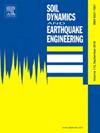位移相关自定心变摩擦阻尼器的实验与数值模拟分析
IF 4.2
2区 工程技术
Q1 ENGINEERING, GEOLOGICAL
引用次数: 0
摘要
利用碟形弹簧组的自定心能力和阶梯形摩擦板的能量耗散特性,提出了一种基于位移的自定心可变摩擦阻尼器(DSVFD),以减轻地震后结构的残余位移。通过循环加载试验结合有限元分析,研究了摩擦板预紧力、加载位移幅值和加载循环次数对阻尼器自定心和耗能性能的影响。这些结果表明,增加摩擦板预紧力可以提高阻尼器的耗能能力,但会对自定心率产生不利影响。增加加载位移显著增加了耗能,而增加加载循环次数对性能的影响可以忽略不计。在考虑不同摩擦盘预紧力的情况下,实验结果与数值模拟结果具有较强的相关性。进一步的参数分析表明,摩擦片倾角的增加增加了DSVFD的峰值载荷、加载刚度和自定心能力。此外,摩擦片间动摩擦系数的增加增加了阻尼器的能量耗散,但降低了阻尼器的自定心能力。本文章由计算机程序翻译,如有差异,请以英文原文为准。
Experimental and numerical simulation analyses of a displacement-dependent self-centering variable friction damper
A displacement-dependent self-centering variable friction damper (DSVFD) was proposed to mitigate the residual displacement of structures following seismic events by utilizing the self-centering capabilities of a disc spring group and the energy dissipation features of a stepped friction plate. Cyclic loading tests coupled with finite element analyses were conducted to examine the impacts of the friction plate preload, loading displacement amplitude, and number of loading cycles on the damper's self-centering and energy dissipation behaviors. These findings suggest that increasing the friction plate preload improves the energy dissipation capacity of the damper, although it adversely affects the self-centering rate. Increasing the loading displacement significantly increased the energy dissipation, whereas increasing the number of loading cycles had a negligible effect on the performance. A comparison between the experimental results, considering various friction disc preloads, and the numerical simulations demonstrates a strong correlation. Further parametric analyses revealed that increasing the inclination angle of the friction plate increased the peak load, loading stiffness, and self-centering capability of the DSVFD. Additionally, an increase in the kinetic friction coefficient between the friction plates enhances energy dissipation but diminishes the self-centering ability of the damper.
求助全文
通过发布文献求助,成功后即可免费获取论文全文。
去求助
来源期刊

Soil Dynamics and Earthquake Engineering
工程技术-地球科学综合
CiteScore
7.50
自引率
15.00%
发文量
446
审稿时长
8 months
期刊介绍:
The journal aims to encourage and enhance the role of mechanics and other disciplines as they relate to earthquake engineering by providing opportunities for the publication of the work of applied mathematicians, engineers and other applied scientists involved in solving problems closely related to the field of earthquake engineering and geotechnical earthquake engineering.
Emphasis is placed on new concepts and techniques, but case histories will also be published if they enhance the presentation and understanding of new technical concepts.
 求助内容:
求助内容: 应助结果提醒方式:
应助结果提醒方式:


